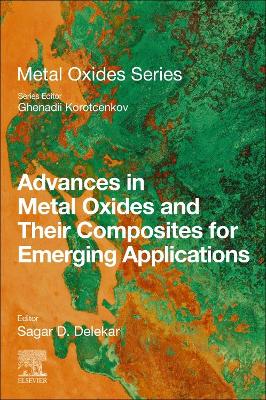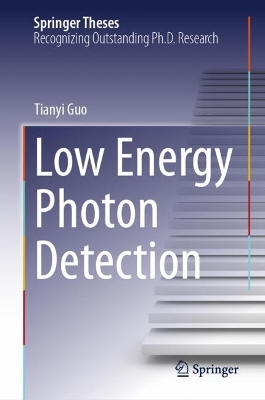Advances in Metal Oxides and Their Composites for Emerging Applications
 -10%
portes grátis
-10%
portes grátis
Advances in Metal Oxides and Their Composites for Emerging Applications
Delekar, Sagar D.
Elsevier - Health Sciences Division
08/2022
746
Mole
Inglês
9780323857055
15 a 20 dias
450
Descrição não disponível.
Part 1. Introduction to Metal Oxide-Based Composites
1. Metal Oxide Engineering via Phase and Composition Control
2. Metal Oxide Based Composites: Synthesis and Characterization
Part 2. Metal Oxides-Based Composites in Energy Technologies
3. Metal oxide nanocomposites for energy storage applications
4. Metal Oxide-based Nanocomposites for Supercapacitive Applications
5. Metal Oxides-Based Composites as Anodes in Lithium Ion Batteries
6. Metal Oxides Based Composites and their Applications in Fuel Cells
7. Metal Oxide Nanomaterials for Organic Photovoltaic Applications
8. Hybrids of Nanocrystalline Metal Oxide-based Composites for Third Generations Solar Cells Technologies
9. Role of Metal Oxides as Photoelectrode in Dye-Sensitized Solar Cells
10. Nanostructured Inorganic Metal Oxide-MOF-based Electrodes for Solar Cells
11. Metal Oxides as Photoanode and Cathode for Water Oxidation and Reduction for Harvesting Hydrogen Fuel
Part 3. Other Applications of Metal Oxides-Based Composites
12. Analytical Applications of Metal Oxides
13. Mixed Metal Oxides Nanocomposites for Environmental Remediation
14. Metal Oxide Nanocomposites in Water and Wastewater Treatment
15. Self-cleaning Photoactive Metal Oxide Based Concrete Surfaces for Environmental Remediation
16. Metal Oxide Nanocomposites: Design and Their Use in Antimicrobial Coatings
17. Metal Oxide Composites in Organic Transformations
18. Metal Oxide Based Composites as Photocatalysts
1. Metal Oxide Engineering via Phase and Composition Control
2. Metal Oxide Based Composites: Synthesis and Characterization
Part 2. Metal Oxides-Based Composites in Energy Technologies
3. Metal oxide nanocomposites for energy storage applications
4. Metal Oxide-based Nanocomposites for Supercapacitive Applications
5. Metal Oxides-Based Composites as Anodes in Lithium Ion Batteries
6. Metal Oxides Based Composites and their Applications in Fuel Cells
7. Metal Oxide Nanomaterials for Organic Photovoltaic Applications
8. Hybrids of Nanocrystalline Metal Oxide-based Composites for Third Generations Solar Cells Technologies
9. Role of Metal Oxides as Photoelectrode in Dye-Sensitized Solar Cells
10. Nanostructured Inorganic Metal Oxide-MOF-based Electrodes for Solar Cells
11. Metal Oxides as Photoanode and Cathode for Water Oxidation and Reduction for Harvesting Hydrogen Fuel
Part 3. Other Applications of Metal Oxides-Based Composites
12. Analytical Applications of Metal Oxides
13. Mixed Metal Oxides Nanocomposites for Environmental Remediation
14. Metal Oxide Nanocomposites in Water and Wastewater Treatment
15. Self-cleaning Photoactive Metal Oxide Based Concrete Surfaces for Environmental Remediation
16. Metal Oxide Nanocomposites: Design and Their Use in Antimicrobial Coatings
17. Metal Oxide Composites in Organic Transformations
18. Metal Oxide Based Composites as Photocatalysts
Este título pertence ao(s) assunto(s) indicados(s). Para ver outros títulos clique no assunto desejado.
Adsorption process; Air depollution; Antimicrobial applications; Bandgap; Biological studies; Biological waste treatment; Biosensor; Bioseparations engineering; CV and GCD curves; Catalysis; Cathode; Chemical engineering; Chemical reaction; Chemical reaction engineering; Classification of hyperthermia; Composite materials; Degradation process; Doping; Dye-sensitized solar cells; Electrochemical biosensors; Electrochemical energy engineering; Electrochemical energy storage; Electrochemical materials science; Electrochemistry; Energy density; Environmental nanotechnology; Environmental pollution; Environmental remediation; HOMO-LUMO levels; Heterogeneous catalyst; Hybrid supercapacitor; Hybrids metal oxide; Intercalation; Ion transport; MOF derived metal oxides; Magnetic hyperthermia therapy; Magnetic materials; Market size; Materials application; Materials characterization; Materials chemistry; Materials science; Materials science engineering; Materials synthesis; Membrane system; Metal oxide; Metal oxide nanocomposites; Metal oxide nanomaterials; Metal oxide-based catalysts; Metal oxides; Metal-organic frameworks; Metal-organic frameworks; Microbes inactivation; Microstructure; Mixed metal oxides; Modification of metal oxides; Multianalyte sensing; Nanoadsorbents; Nanocomposite; Nanocomposites; Nanoparticles; Nanostructures; Nanotechnology; Ni foam; Organic solar cells; Organic transformation; Photoactive concrete; Photoanode; Photocatalyst; Photoelectrodes for DSSCs; Physico-chemical process; Porous material; Power density; Present cancer treatment; Pseudocapacitance; Redox reactions; Renewable energy source; Renewable energy sources; Self cleaning; Self-disinfecting; Shockley-Queisser limit; Solar cell; Solar cells; Solar energy technologies; Specific capacitance; Supercapacitor; Supermagnestism; Surface; Surface property; Sustainability engineering; Sustainable energy; Synergy of oxygen vacancy; Synthesis and applications of metal oxide nanocomposites; Transition metal oxides; WO3-x; Water management; Water pollution; Water splitting; Water technology
Part 1. Introduction to Metal Oxide-Based Composites
1. Metal Oxide Engineering via Phase and Composition Control
2. Metal Oxide Based Composites: Synthesis and Characterization
Part 2. Metal Oxides-Based Composites in Energy Technologies
3. Metal oxide nanocomposites for energy storage applications
4. Metal Oxide-based Nanocomposites for Supercapacitive Applications
5. Metal Oxides-Based Composites as Anodes in Lithium Ion Batteries
6. Metal Oxides Based Composites and their Applications in Fuel Cells
7. Metal Oxide Nanomaterials for Organic Photovoltaic Applications
8. Hybrids of Nanocrystalline Metal Oxide-based Composites for Third Generations Solar Cells Technologies
9. Role of Metal Oxides as Photoelectrode in Dye-Sensitized Solar Cells
10. Nanostructured Inorganic Metal Oxide-MOF-based Electrodes for Solar Cells
11. Metal Oxides as Photoanode and Cathode for Water Oxidation and Reduction for Harvesting Hydrogen Fuel
Part 3. Other Applications of Metal Oxides-Based Composites
12. Analytical Applications of Metal Oxides
13. Mixed Metal Oxides Nanocomposites for Environmental Remediation
14. Metal Oxide Nanocomposites in Water and Wastewater Treatment
15. Self-cleaning Photoactive Metal Oxide Based Concrete Surfaces for Environmental Remediation
16. Metal Oxide Nanocomposites: Design and Their Use in Antimicrobial Coatings
17. Metal Oxide Composites in Organic Transformations
18. Metal Oxide Based Composites as Photocatalysts
1. Metal Oxide Engineering via Phase and Composition Control
2. Metal Oxide Based Composites: Synthesis and Characterization
Part 2. Metal Oxides-Based Composites in Energy Technologies
3. Metal oxide nanocomposites for energy storage applications
4. Metal Oxide-based Nanocomposites for Supercapacitive Applications
5. Metal Oxides-Based Composites as Anodes in Lithium Ion Batteries
6. Metal Oxides Based Composites and their Applications in Fuel Cells
7. Metal Oxide Nanomaterials for Organic Photovoltaic Applications
8. Hybrids of Nanocrystalline Metal Oxide-based Composites for Third Generations Solar Cells Technologies
9. Role of Metal Oxides as Photoelectrode in Dye-Sensitized Solar Cells
10. Nanostructured Inorganic Metal Oxide-MOF-based Electrodes for Solar Cells
11. Metal Oxides as Photoanode and Cathode for Water Oxidation and Reduction for Harvesting Hydrogen Fuel
Part 3. Other Applications of Metal Oxides-Based Composites
12. Analytical Applications of Metal Oxides
13. Mixed Metal Oxides Nanocomposites for Environmental Remediation
14. Metal Oxide Nanocomposites in Water and Wastewater Treatment
15. Self-cleaning Photoactive Metal Oxide Based Concrete Surfaces for Environmental Remediation
16. Metal Oxide Nanocomposites: Design and Their Use in Antimicrobial Coatings
17. Metal Oxide Composites in Organic Transformations
18. Metal Oxide Based Composites as Photocatalysts
Este título pertence ao(s) assunto(s) indicados(s). Para ver outros títulos clique no assunto desejado.
Adsorption process; Air depollution; Antimicrobial applications; Bandgap; Biological studies; Biological waste treatment; Biosensor; Bioseparations engineering; CV and GCD curves; Catalysis; Cathode; Chemical engineering; Chemical reaction; Chemical reaction engineering; Classification of hyperthermia; Composite materials; Degradation process; Doping; Dye-sensitized solar cells; Electrochemical biosensors; Electrochemical energy engineering; Electrochemical energy storage; Electrochemical materials science; Electrochemistry; Energy density; Environmental nanotechnology; Environmental pollution; Environmental remediation; HOMO-LUMO levels; Heterogeneous catalyst; Hybrid supercapacitor; Hybrids metal oxide; Intercalation; Ion transport; MOF derived metal oxides; Magnetic hyperthermia therapy; Magnetic materials; Market size; Materials application; Materials characterization; Materials chemistry; Materials science; Materials science engineering; Materials synthesis; Membrane system; Metal oxide; Metal oxide nanocomposites; Metal oxide nanomaterials; Metal oxide-based catalysts; Metal oxides; Metal-organic frameworks; Metal-organic frameworks; Microbes inactivation; Microstructure; Mixed metal oxides; Modification of metal oxides; Multianalyte sensing; Nanoadsorbents; Nanocomposite; Nanocomposites; Nanoparticles; Nanostructures; Nanotechnology; Ni foam; Organic solar cells; Organic transformation; Photoactive concrete; Photoanode; Photocatalyst; Photoelectrodes for DSSCs; Physico-chemical process; Porous material; Power density; Present cancer treatment; Pseudocapacitance; Redox reactions; Renewable energy source; Renewable energy sources; Self cleaning; Self-disinfecting; Shockley-Queisser limit; Solar cell; Solar cells; Solar energy technologies; Specific capacitance; Supercapacitor; Supermagnestism; Surface; Surface property; Sustainability engineering; Sustainable energy; Synergy of oxygen vacancy; Synthesis and applications of metal oxide nanocomposites; Transition metal oxides; WO3-x; Water management; Water pollution; Water splitting; Water technology







